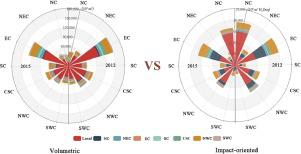Resources, Conservation and Recycling ( IF 11.2 ) Pub Date : 2022-07-28 , DOI: 10.1016/j.resconrec.2022.106573 Linxiu Wu , Kai Huang , Yingying Ren , Yajuan Yu , Baorong Huang

|
The scarcity and spatial mismatch of water resources exert increasing pressure on global water sustainability. Interregional virtual water transfer through trade can alleviate or aggravate pressure on water resources because of the heterogeneity in regional water endowments. However, previous studies have mainly focused on volumetric virtual water transfers without considering actual impacts on local water resources. This study compares the volumetric and impact-oriented water footprints (WFs) in China in 2012 and 2015 using a multiregional input–output model (MRIO). Unlike the volumetric WF, which focuses on the volume of water used, the impact-oriented WF refers to the potential environmental impacts of water withdrawal in view of water availability. The results show a clear gap between the pattern of the volumetric virtual water flow and that of the impact-oriented virtual water flow. As a water-scarce region, North China imported 23824×106 m3 and 12338×106 m3 of volumetric virtual water from other regions in 2012 and 2015, respectively, but exported a large amount of impact-oriented virtual water to almost all other regions. Additionally, most water-rich regions transferred water scarcity risk as virtual water importers to water-scarce regions. For example, the largest net impact-oriented virtual water flows in 2012 (4421×106 m3 H2Oeq) and 2015 (4014×106 m3 H2Oeq) were from North China to East China. Our results highlight the importance of simultaneously considering both the volume and the impact of water use in virtual water trade analyses. Understanding these mechanisms is essential for helping to identify the actual receivers of water scarcity risk in virtual water trade network and develop sustainable virtual water strategies.











































 京公网安备 11010802027423号
京公网安备 11010802027423号